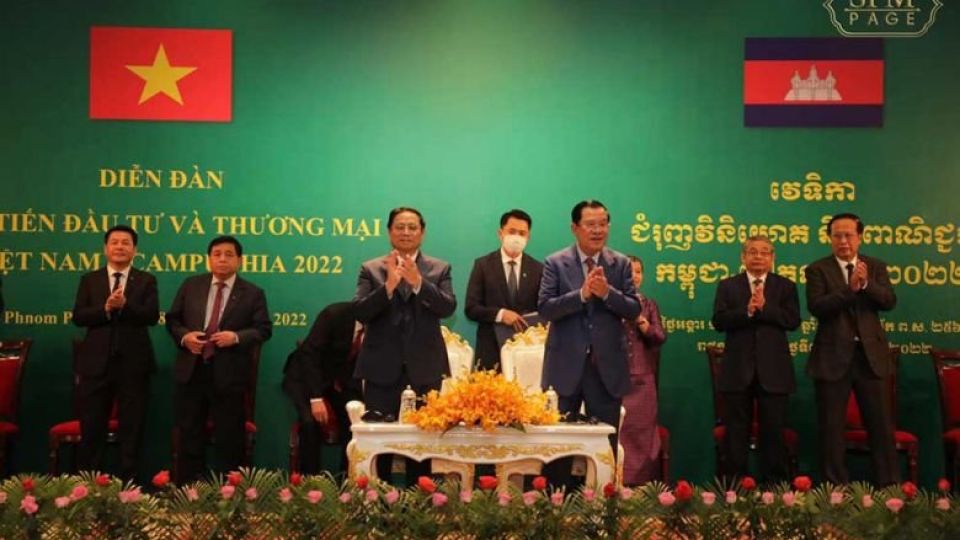July 28, 2023
PHNOM PENH – Vietnam remains Cambodia’s chief trading partner in ASEAN, accounting for nearly half of Cambodia’s goods trade with its fellow bloc members in the first six months of this year.
The first half of 2023 marked the fourth consecutive six-month period Vietnam has held this position, trailing only China and the US in terms of global rankings.
This trend begs an intriguing question: Why has Cambodia seen an increase in commodities trading with Vietnam in recent years, surpassing its two other neighbours, Thailand and Laos, and other ASEAN nations?
Data from the General Department of Customs and Excise of Cambodia (GDCE) published on July 10 provides some answers. According to GDCE, Cambodia exported goods worth $1.43 billion to Vietnam between January and June, an increase of 21.67 per cent from the same period a year ago.
However, imports from Vietnam totalled $1.87 billion, marking a decrease of 10.25 per cent year on year.
This translates to a combined trade volume of $3.3 billion, reflecting a slight annual increase of 1.25 per cent, compared to the significant growth of 22.33 per cent seen a year prior.
Interestingly, Vietnam constitutes almost half of Cambodia’s international land borders, spanning 1,270km and neighbouring nine of Cambodia’s 24 provinces, more than Thailand’s seven and Laos’ two.
Such geography, according to Ministry of Commerce spokesman Penn Sovicheat, has bolstered bilateral trade growth, particularly of goods heading from Cambodia to Vietnam.
“Cambodia and Vietnam share a frontier, making cross-border transport easier and bringing down associated costs, thereby driving trade growth,” Sovicheat said.
He also pointed out a recent surge in Vietnamese orders for commodities, intended for processing and re-export, including paddy rice, cassava, cashews and natural rubber.
Processed foods and construction materials were highlighted as notable imports from Vietnam.
The increase in Vietnam’s agricultural raw material imports from Cambodia, according to Sovicheat, can be largely attributed to Vietnam’s free trade agreement (FTA) with the EU, which came into effect on August 1, 2020.
FTAs aim to reduce or eliminate specific import and export barriers, while generally maintaining safety, security, health and other regulatory objectives. They can also strengthen economic ties among members in areas such as investment and intellectual property protection.
While Thailand shares an approximately 803km border with Cambodia, trade between the two nations falls short compared to Vietnam.
This is not a fixed pattern, however, as Penn Sovicheat explained: “Thailand in some years has more trade with Cambodia than Vietnam. We recognised that trade between Thailand and Cambodia has increased seasonally.
“Therefore, as for agricultural goods, compared to the two countries, Thailand and Vietnam, it was easier for us to export to Vietnam, even though Thailand also borders us.”
‘Bustling trade activity’
Both the private sector and economic analysts in Cambodia consider Vietnam an essential trading partner for the nation, both regionally and globally.
Lim Heng, vice-president of the Cambodia Chamber of Commerce (CCC), noted that Vietnam is Cambodia’s primary export market for raw materials, particularly agricultural products.
“Leaders from both Cambodia and Vietnam have created a peaceful border and shared markets along these lines. Existing cross-border trade agreements between the two nations further support cooperation.
“Moreover, infrastructure initiatives, like the ongoing construction of the Phnom Penh-Bavet Expressway, testify to the bustling trade activity between the two countries,” Heng said.
It was hoped the Vietnam economy remained strong, he added.
“When Vietnam has a strong economy, it boosts our exports. Most of our agricultural products, processed and unprocessed, have depended on the Vietnamese and Thai markets.
“Without these two countries, we could have encountered difficulties,” he said.
According to Yourng Pakk, an agricultural expert in Cambodia, the shared borders make it natural for the two countries to exchange commodities, particularly agricultural products.
This exchange involves Cambodia exporting industrial crops that Vietnam lacks domestically for processing and exports, and importing daily use agricultural products like vegetables and fruits from Vietnam.
“Consider vegetables as an example. While we grow a variety of vegetables in our country, we don’t cultivate all types, which include both root and leafy vegetables,” he said.
“Hence, we have to import some of these from Vietnam. In addition, we export our locally grown vegetables to Vietnam as well. This type of exchange is typical between neighbouring countries.”
Pakk urges the government to reduce imports by providing enough fruits and vegetables in the country, strengthening agricultural communities, setting up processing facilities, and offering low-interest capital to farmers.
Supporting Lim Heng’s comments, Royal Academy of Cambodia economist Ky Sereyvath believes geographical factors and Vietnam’s economic growth have strengthened trade relations between Cambodia and Vietnam.
“Vietnam will still be an important trading partner of Cambodia, thanks to the rapid economic growth of Vietnam in recent years,” Sereyvath said.
Knock-on effect
Vietnamese investors have increasingly invested in Cambodia in the cultivation and processing of horticultural crops such as bananas and mangoes, as well as agro-industrial crops like rubber, cassava, and cashew nuts, he added. This in turn drives the growth of exports to Vietnam.
Indeed, the prevailing consensus is that geography, border proximity and Vietnam’s robust economic growth have been instrumental in making it Cambodia’s largest trading partner within ASEAN.
These factors have consistently enhanced the trade relationship between the two countries.
As Vietnam’s economy continues to flourish, it has a knock-on effect on Cambodia’s agricultural market, stimulating growth.
These beneficial impacts are not just felt in the present – they are also expected to continue into the future.
The mutually beneficial trading relationship between Vietnam and Cambodia is a testament to the power of close geographical ties and thriving economies in driving regional commerce.
In a world where economic landscapes can shift rapidly, these insights underscore the enduring significance of traditional factors like geographic proximity and economic growth in shaping international trade dynamics.
As we move forward, Cambodia and Vietnam’s relationship stands as a compelling example of what two neighbouring countries can achieve through collaboration and mutual economic growth.


